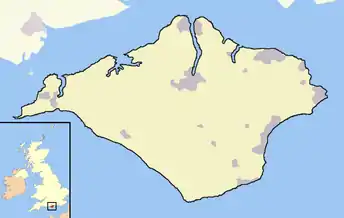Wihtwara
Wihtwara was the kingdom founded on the Isle of Wight, a 147-square-mile (380 km2) island off the south coast of England, during the Anglo-Saxon settlement of Britain. The name was derived from the Jutish name Wihtwara ("Men of Wiht"). Its capital was a fort named Wihtwarasburgh. It has been suggested that the modern-day village of Carisbrooke was built on top of Wihtwarasburgh due to the fact that they share their location. It has also been suggested that Wihtwarasburgh was built on top of a pre-existing Roman fort, but this has not been proven.
Wihtland | |||||||||
|---|---|---|---|---|---|---|---|---|---|
| Capital | Wihtgarsburgh | ||||||||
| Religion | Anglo-Saxon paganism, Anglo-Saxon Christianity | ||||||||
| Government | Monarchy | ||||||||
| |||||||||
| Today part of | |||||||||

Jutish history
Wihtland was the name given to the Isle of Wight. The Wihtwara were the people of Wihtland, supposedly after Wihtgar who, along with Stuf, was one of the two earliest kings of Wihtland (from 512, as recorded by St Bede). Wihtgar and Stuf were supposedly nephews of Cerdic, the founder of the Wessex dynasty known only as the Gewisse (literally "Allies").[1] Some scholars have suggested that Wihtgar may have been fictitious: that is, the central figure of a founding myth invented retrospectively, to justify the name.[2] The Anglo-Saxon Chronicle differs, however, instead claiming that Wihtgar and Stuf received the land from Cerdic's son Cynric in 534, with the death of Wihtgar taking place in 544.
Subsequent kings are unknown until the final Jutish king, Arwald, who was probably born in the mid 7th Century. In 661 Wulfhere of Mercia conquered Wessex and gave the overlordship to his godson, King Aethelwalh of Sussex and forced the Islanders to convert to Christianity. After Wulfhere's departure the island returned to paganism. Arwald was reportedly killed resisting an invasion in 686 by King Caedwalla of Wessex (under the tutelage of St Wilfrid) together with his brother Mul of Kent.[3] According to Bede, Caedwalla "endeavoured to destroy all the inhabitants" of Wihtland and to replace them with his own followers. However, Bede states that Jutes remained the majority population of the island. When Caedwalla died a few years later, wounds sustained in the fierce fighting against the Wihtwara were reputedly responsible.
A survivor from the alleged massacres of the Wihtwara, was Arwald's sister (whose name is now unknown); through her its ruling dynasty became ancestors of later Anglo-Saxon kings. Arwald's sister was married to King Egbert of Kent (at the time also a Jutish kingdom besieged by Caedwalla and his brother, Mul). Arwald's sister was therefore, apparently, the mother of King Wihtred of Kent and grandmother of Æthelbert II of Kent. Æthelbert was the grandfather of Egbert of Wessex, who was, in turn, the paternal grandfather of King Alfred the Great.
Later Middle Ages
After the Norman Conquest the Isle of Wight was given to the de Redvers family in 1101 who were known as "Lords of the Isle of Wight". However the last of them was Izabel de Forz (also known as Isabella de Fortibus; 1237–1293), who was known informally as the "Queen of the Isle of Wight". Forz was visited shortly before her death by King Edward Longshanks (known later as Edward I), who said later that she had sold the Isle of Wight to him for 6,000 marks. The village of Queens Bower is said to be named after her.
In 1444, Henry Beauchamp, Duke of Warwick a favourite of King Henry VI was given the title (or perhaps nickname) of King of the Isle of Wight. Beauchamp died shortly afterwards and the title was not used again.[4][5] The closest existing title at that time - the Lordship of the Isle of Wight - was held by the uncle of King Henry VI, Humphrey, Duke of Gloucester, after being bestowed it in 1434.[6]
Citations
- While the Gewisse dynasty has never been given a name, presumably it would have been named after its founder — just as the kings of Kent and East Anglia were, respectively, the Oiscings and Wuffings after Oisc and Wuffa.
- Stenton, Yorke et al.
- "Britannia: The AngloSaxon Chronicle". www.britannia.com. Retrieved 20 December 2018.
- Chisholm, Hugh, ed. (1911). . Encyclopædia Britannica. Vol. 28 (11th ed.). Cambridge University Press. p. 338.
- Dictionary of National Biography (New York: Macmillan, 1985) vol. 4, p. 28
- "GLOUCESTER, Humphrey duke of (Protector of England) - Archontology.org". www.archontology.org. Retrieved 20 December 2018.
General references
- St. Bede History of the English Church
- Eddius Stephanus Vita Dunstani
- Henry Beauchamp